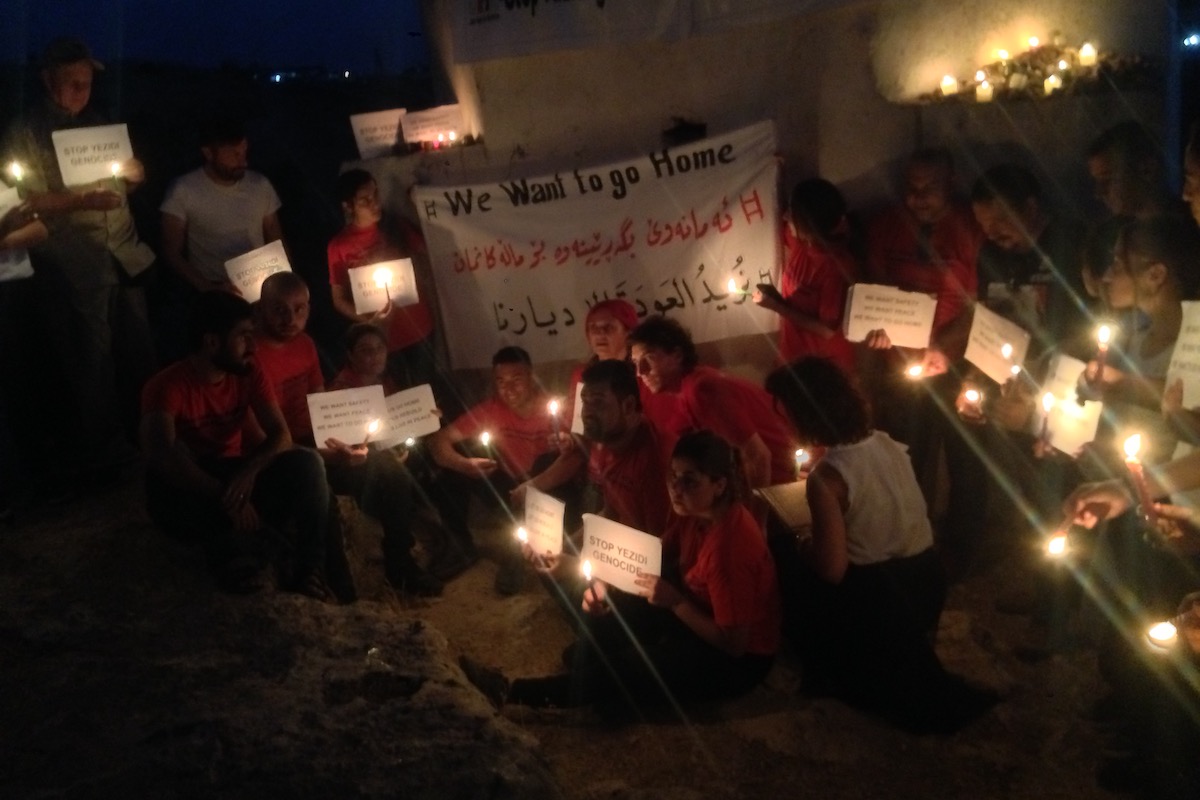For the Yezidis August 3, the anniversary of the infamous genocide perpetrated by the Islamic State against their community, has yet again come and gone. It’s now been five years since the Islamic State attacked the Yezidi homeland in Sinjar on August 3, 2014, destroyed their city and towns, killed at least 2,000 people in a matter of days and carted away thousands of Yezidi women and girls into unimaginably horrific lives as “sex-slaves” for the militants. Many more have remained unaccounted for ever since even though the Islamic State caliphate has been destroyed.
Yezidis of the Bajed Kandala 2 camp in Iraqi Kurdistan, located near the border with Syria, commemorate the beginning of the genocide every August 3. Survivors tearfully recount their plight and appeals by the main charity at the camp, Joint Help for Kurdistan, are made for donations.
This year a candlelit vigil was held at a small Yezidi temple near BK2. This is the second year in a row that Yezidis from this camp were denied access to Sinjar by Iraq. Baghdad seized Sinjar from the Kurds, who had hitherto controlled it for many years, in the aftermath of their independence referendum in 2017. Consequently, BK2 residents have not been able to get permission to return to Sinjar and stage commemorations and protests there like they could when it was under Kurdistan’s control.
In 2016, Yezidis from BK2 visited Sinjar for the first time since the genocide – the Islamic State was pushed out of the city the previous November. The reality of the city’s destruction was clearly brought home to them. Nevertheless, as I suggested at the time to a TV crew asking me about the significance of the occasion, holding the protest at the site of the crime against humanity for the first time was progress of a kind. However, upon looking at the shattered ruins of the city the word ‘progress’ doesn’t have any real resonance.
I first visited BK2 camp in December 2015 and have occasionally revisited since. During this last visit, I was struck by how increasingly more permanent the camp feels. It was initially built as a temporary camp – BK1, situated just across the road over which trucks constantly rumble past day and night, was built for Syrian refugees in Iraqi Kurdistan before the Islamic State war began – made-up of U.N. tents which were supposed to serve only as temporary shelters. Today, some Yezidis have built small structures out of concrete. Others have made the best of their small spaces and have even grown small gardens in their yards.
There is a bazaar where youths hang out in small makeshift, but comfortable, cafes. There are also liquor stores and even a small jewellery shop.
For many Yezidis, gradually transforming the camp into a more permanent village would amount to abandoning their resolve of returning to Sinjar. One of the signs the Yezidis carried in their commemoration/protest read ‘we want to go home.’
“Nobody wants to go home now,” one Yezidi said to me upon seeing that sign.
Sinjar remains in ruins. The threat of Islamic State remnants to that area also can never be dismissed. As a result, Yezidis will either continue to live in camps, start new lives elsewhere in the region or emigrate altogether, which many have already done. The dire reality is that the community won’t be able to return and rebuild Sinjar in any meaningful way for the foreseeable future given the lack of proper authority, security and services in the region.
Half-a-decade after the genocide against their entire community began many Yezidis remain missing. Others were in constant Islamic State captivity until very recently. For example, after the Syrian town of Baghouz, the Islamic State caliphate’s last redoubt, was liberated early this year the first thing one freed Yezidi boy asked was: “Did anything happen to Sinjar?”
Other Yezidis are essentially trapped in the notorious Al-Hol camp in northeast Syria, which is full of Islamic State sympathizers. They are afraid to risk exposing their identity or try to alert the camp’s Kurdish-led authorities out of fear that the thousands of fanatical former Islamic State ‘brides’ and sympathizers there will attack or even murder them.
And in northwest Syria, the few thousand Yezidis who used to call the Kurdish Afrin enclave home had to flee the Turkish invasion in early 2018 and now live in displaced person camps outside the region, too afraid to return home out of fear of what Turkish-backed Syrian militants will do to them.
It’s against this bleak backdrop that Yezidis once again have to contemplate what the future has in store for them half-a-decade after the Islamic State tried to erase their community and culture from the face of the earth.
Photo caption: Yezidi survivors from Bajed Kandala 2 camp and Joint Help for Kurdistan volunteers hold a candlelight vigil to mark the fifth anniversary of Yezidi genocide. August 3, 2019. Author photo.

